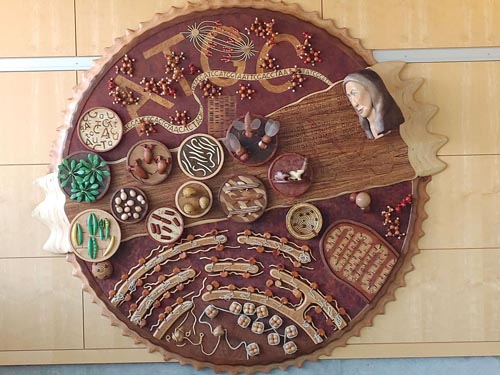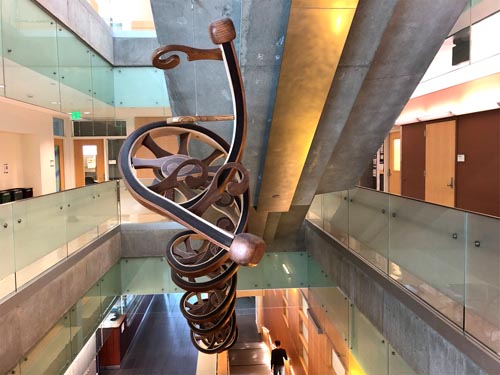Foege Building Sculptures
Jim is a graduate of the University of Washington, Department of Chemistry, and the University of Washington, School of Medicine. After his retirement from Evergreen Hospital in Kirkland where he worked as a General Surgeon, Jim created his very first sculpture, entitled Double Helix, which he donated to Genome Sciences in 2015.
DNA occupies the central position in biology. This sculpture is an artistic representation of DNA meant to capture the imagination and inspire those who understand its subject matter. The double helix form grabs the eyes demanding attention. The four nucleotides are depicted in padauk, Peruvian walnut, leopard wood, and zebra wood. They are made with a clasping theme suggestive of the Yin Yang symbol using a maple strip joining the two sides. There are 31 pairs in the sculpture that makes four revolutions.
 Genomic Journey
Genomic Journey
by James Mhyre
The upper panel is an abstract mashup of biological information, both DNA and RNA and a cell in mitosis. The smaller molecules depict different nucleotides. Genetic information spills into the middle panel and is represented as digital code, 0’s and 1’s.
The middle panel contains 10 circles representing the most common genetic model organsisms used for research starting with Mendel’s peas on the left, thale cress, yeast, E. coli, frog, protozoa, worm, zebra fish, fruit fly, and mouse. The human figure represents humans studying the biological processes before us. The back of her head is open, exposing her occipital lobes and cerebellum, emphasizing that we too are the biology that we are studying.
The lower panel depicts the central dogma of biochemistry, translating DNA into proteins. DNA is unwound and copied by the RNA polymerase into messenger RNA. It is then modified and leaves the nucleus for the endoplasmic reticulum where it is read by the ribosomes to produce the encoded proteins. Also in the lower panel is a mitochondria, the cellular powerhouse, and a molecule of Adenosine Triphosphate (ATP), the currency of cellular energy.
